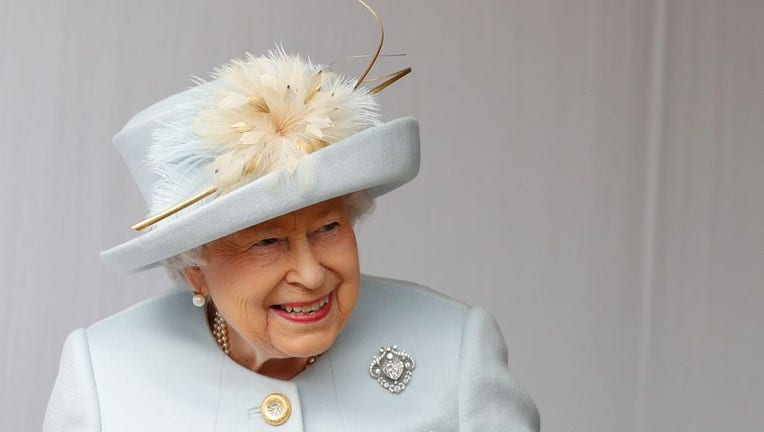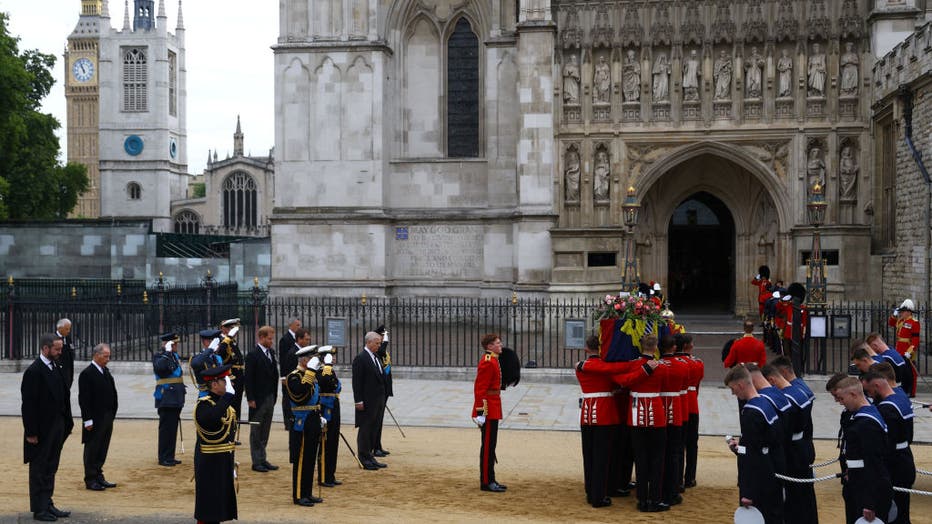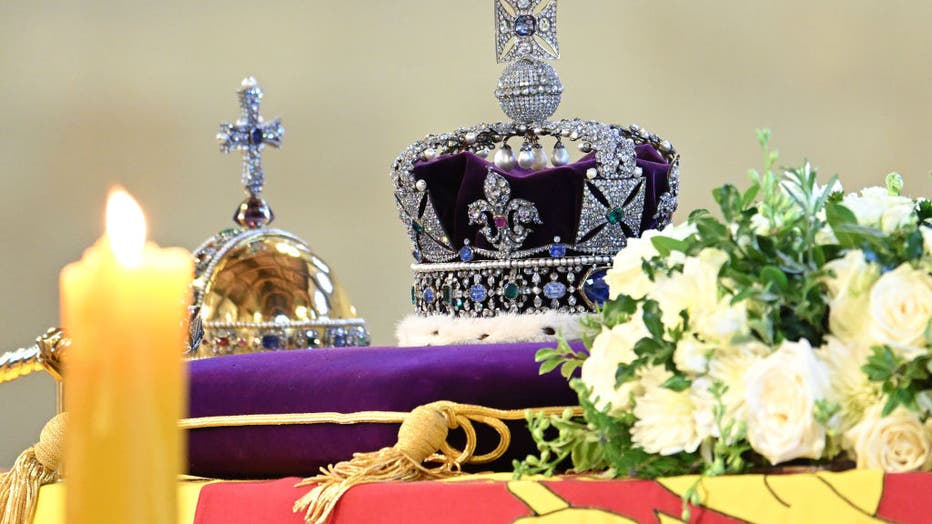Queen Elizabeth II and the Church of England: The late monarch's faith beliefs

Britain's Queen Elizabeth II waits for the carriage carrying Princess Eugenie of York and her husband Jack Brooksbank to pass at the start of the procession after their wedding ceremony at St George's Chapel, Windsor Castle, in Windsor, on October 12
Queen Elizabeth II will be buried in a state funeral at Westminster Abbey in London on Monday, Sept. 19, 2022.
The queen died on Sept. 8, 2022, at 96 years old, at her Scottish castle, Balmoral.
Queen Elizabeth II was a member of the Church of England.
Sometimes referred to as the Anglican Church, the Church of England is part of the Anglican Communion, which itself contains different branches of Christianity, such as the Protestant Episcopal Church, according to History.com.
The Church of England is the "primary state church" in England and claims to be both Catholic and Reformed, the same source notes.
The church "upholds teachings found in early Christian doctrines, such as the Apostles Creed and the Nicene Creed," and also "reveres 16th century Protestant Reformation ideas outlined in texts, such as the Thirty-Nine Articles and the Book of Common Prayer," it notes as well.
Jonathan Neil-Smith, who served as former Secretary to the Dioceses Commission and House of Clergy, as well as Secretary to the House of Bishops, told Fox News Digital via email that all monarchs are required to "either be a member of the Church of England" or of "a church in communion with it."
PASTOR MAX LUCADO SHARES MESSAGE OF HOPE FOR THE WEARY IN NEW FAITH BOOK
Neil-Smith, who is from Surrey, England, also said, "We have been richly blessed to have had a monarch in the late Queen Elizabeth who has participated in the life of the Church of England and in expounding the teachings of Jesus Christ, regularly referring to them in her annual Christmas broadcasts."
‘Christian belief meant a lot to the queen’
The passing of the queen is "the end of an era, a major shift," Professor Murray Pittock, a Scottish historian and Bradley Professor of Literature at the University of Glasgow in Glasgow, Scotland, told Fox News Digital in a recent phone interview.
"The Queen led a long life" and it was "very well spent," he said.
"She had that overall, overriding sense of duty at the expense of personal pleasure, something which is not very common nowadays," he added.
QUEEN ELIZABETH II'S TIARAS AND THE SPARKLING STORIES BEHIND THEM
"Christian belief meant a lot to the queen," said Pittock.
"And seems to me it means quite a lot to King Charles, too."
In 1977, as part of her Silver Jubilee, "Her Late Majesty visited Westminster Roman Catholic Cathedral," said Neil-Smith.
"This was the first visit to a Roman Catholic cathedral by an English monarch since the Reformation."

The coffin of Queen Elizabeth is carried on the day of her state funeral and burial, outside the Westminster Abbey on September 19, 2022 in London, England. /(Photo by Hannah McKay - WPA Pool/Getty Images)
He continued, "In 1961, Her Late Majesty met Pope John XXIII in Rome. She also received Pope John Paul II and Pope Benedict XVI on their visits to the U.K., in 1982 and 2010, respectively."
He added, "By these highly symbolic actions, Her Majesty played her part in healing the historic rift between the Church of England and the Roman Catholic Church."
Neil-Smith said that "the new king is also known to take his faith seriously, and we pray that he will be strengthened in carrying out his new role."
‘Creation of the English monarchy’
The Church of England is itself "a creation of the English monarchy," said Pittock, due to "the demand that the bishops of the Catholic Church in England observe the royal supremacy."
AS QUEEN ELIZABETH II PASSES, AMERICAN FAITH LEADERS SHARE PRAYERS AND SORROW
This creation began with Henry VIII, in 1534, because he "basically wanted the right to divorce Catherine of Aragon to marry Anne Boleyn," noted Pittock.

Queen Elizabeth II receives the Archbishop of Canterbury Justin Welby at Windsor Castle, where he presented her with a special 'Canterbury Cross' for her 'unstinting' service to the Church of England over seventy years and a citation for the Cross, w
(His marriage to Catherine was annulled.)
"There is a struggle, and then the king becomes head of the Church of England — which is really the idea that the monarch is supreme over the Pope when it comes to church appointments and church governance," Pittock explained.
"And in 1558, when Elizabeth [Queen Elizabeth I] comes to the throne, she adopts the title Supreme Governor. This is the title that the Crown still holds in respect of the Church of England," he continued.
As the Supreme Governor, the monarch "formally appoints high-ranking members of the church on the advice of the prime minister of the United Kingdom," who is, in turn, "advised by church leaders, such as the Lords Spiritual," History.com notes.
"It's a role that doesn't altogether make sense — a detached role," said Pittock.
"It means that the nomination of bishops, which effectively are the Crown nominees, are in fact rather like parliamentary legislators, now effectively signed off by the parliamentary executive and agreed to by the monarch."

The coffin carrying Queen Elizabeth II is draped in the Royal Standard and adorned with the Imperial State Crown and the Sovereign's orb and sceptre, rests in Westminster Hall for the Lying-in State on September 17, 2022 in London, England. (Photo by
Neil-Smith explained the crowning of monarchs as it relates to the church.
"English monarchs have been crowned in a church service over which an English bishop — normally the Archbishop of Canterbury — has presided since [King] Edgar’s coronation in 973," he said.
"In this deeply religious service," he continued, "which has many similarities with an ordination of a priest or bishop, the monarch is both crowned and anointed. As part of the anointing ceremony, prayers are said calling upon the Holy Spirit to sanctify the monarch."
The church’s bishops play a lawmaking role in Britain, according to History.com.
Twenty-six bishops sit in the House of Lords, they note, and are referred to as the "Lords Spiritual."
QUEEN ELIZABETH II BY THE NUMBERS: HER HATS, ANIMALS AND WEDDING TO PRINCE PHILLIP
"Rather interestingly, King Charles is also a member of the Church of Scotland while in Scotland, as was the queen," added Pittock.
"They're both Anglicans and also Presbyterians when in Scotland," he said.
"Interestingly, the American Episcopal Church, which is, of course, part of the Anglican Communion, was actually founded not by the Church of England but by the Episcopal Church in Scotland — because that church didn't at that point [in history] recognize the monarchy," he said.
Church of England beliefs
The church upholds many Roman Catholic customs, but it also embraces fundamental ideas adopted during the Protestant Reformation, according to History.com.
Other facts the site conveys about the Church of England:
The Church of England sustains a traditional Catholic order system that includes ordained bishops, priests and deacons.
The church follows an episcopal form of government, divided into two provinces: Canterbury and York. Provinces are separated into dioceses, which are headed by bishops and include parishes.
CLICK HERE TO GET THE FOX NEWS APP
The Archbishop of Canterbury is thought to be the most senior cleric in the church.
Each year, about 9.4 million people visit a Church of England cathedral.
Get updates to this story on FOXNews.com.
Editor's note: Pool video has since been removed from this story due to usage restrictions from the royal family.

